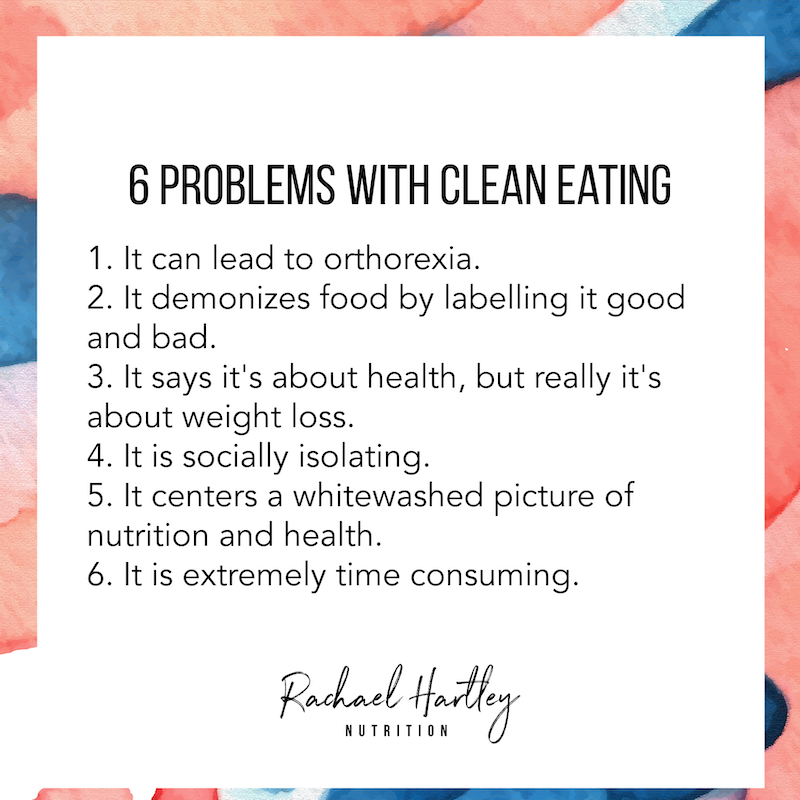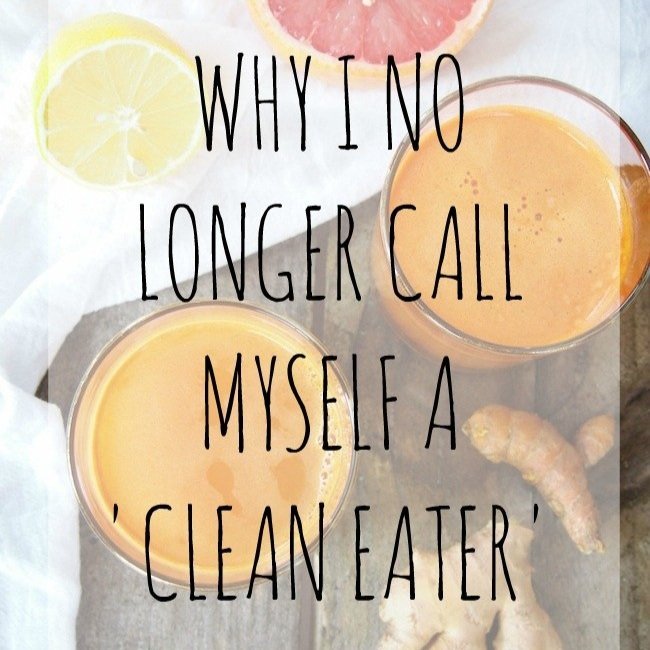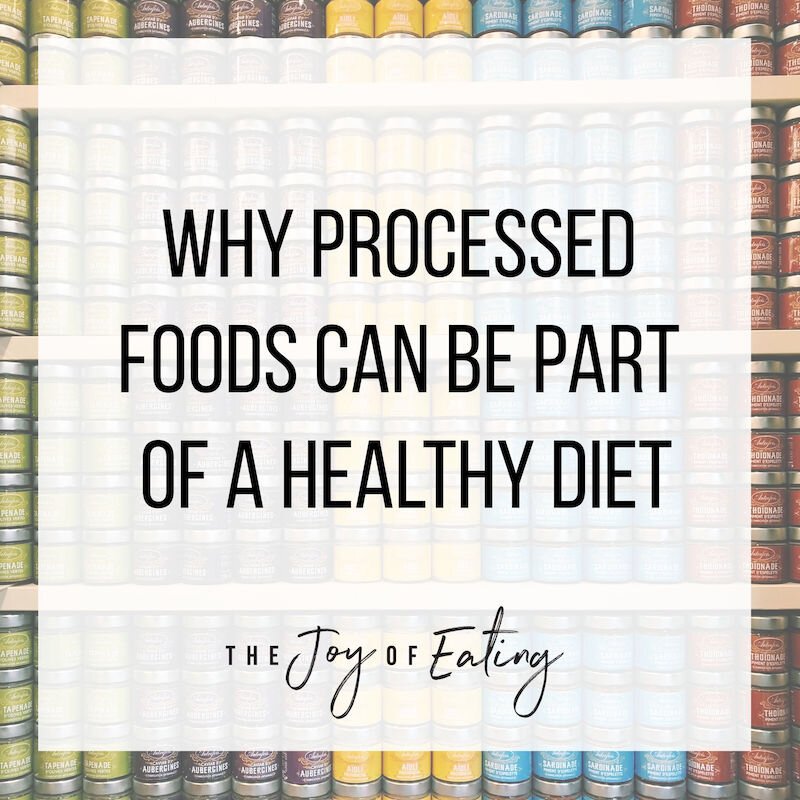The Problems with Clean Eating
With an emphasis on fresh, minimally processed foods, clean eating might be an approach to eating that seems to make logical sense. But when you dig beneath the surface, there’s a lot of problems with clean eating that might not be evident upon first glance. This post discusses how clean eating can go wrong, and what to focus on instead.
Early on in my dietetics career, and even through my first couple years of blogging, I identified as being a “clean eater.” As most practitioners who come to a non-diet approach, I spent a considerable amount of time straddling the fence between two different paradigms. My time as a “clean eater,” which I wrote more about in this blog post, was part of that. At the time, I had come to realize that diets (or at least, my very narrow view of what a diet was) didn’t really work. So what if instead of focusing on weight, we just refocused on “healthy eating.” Sounds kind of like Health at Every Size®, right?
Wrong.
As I came to realize, while clean eating was rooted in something seemingly rational – that eating a dietary pattern rich in fresh foods is generally health promoting - clean eating is yet another rigid and moralistic way of controlling food and making eating stressful, not a way to improve health. Basically, clean eating is just another diet.
The Problems with Clean Eating
There’s no clear definition of what clean eating is
Normally, I would say the lack of rigid rules about eating is a good thing. But in the case of clean eating, it’s created an environment where it’s easy for people to keep cutting more and more foods in pursuit of an ever “cleaner” diet. One’s definition of clean eating can range from eating more fresh foods and minimizing processed foods, which from a nutritional standpoint is totally cool, all the way to cutting out gluten, sugar, meat, dairy and anything that comes from a package, which from a nutritional standpoint is highly likely to be nutritionally deficient.
This continuous cutting out of foods might sound like an exaggeration, but it’s actually a description of an extremely common eating disorder called orthorexia, which has been on the rise as of late, with an estimated prevalence between 1-7% of the population.
One reason it’s so easy to keep cutting out more and more foods is because clean eating demonizes processed foods, and when you actually look at the definition of what processed foods are, almost all foods are processed. Planning on cooking the salmon filet you picked up for dinner? Cooking is technically processing! Want to save time with pre-chopped lettuce? Also processing. Want to enjoy some berries out of season? Frozen foods are processed too.
While most people would agree these are all totally nutritious foods, once you fall down the clean eating rabbit hole, sometimes it’s not so clear. Especially when the voices that proliferate (ahem, Food Babe) are not exactly based in science. Because there is no clear definition of clean eating, many people will continuously cut out more and more foods as they learn more and more (usually inaccurate and fearmongering) information about food. The former clean eaters I’ve worked with describe constant uncertainty around food, as they’re never sure if what they are eating is OK.
Clean eating demonizes food by labelling it “good” or “bad”
Clean eating creates guilt and shame around food by creating hierarchies - clean, good foods vs. dirty, unhealthy bad foods. This binary approach is nutritionally inaccurate. While certainly there are foods that contain more nutrients than others, what makes a food a “healthier” choice is much more nuanced than vitamins, minerals, and fiber. Convenience, social and cultural connection, as well as other situational and individual factors all play roles that are just as important.
Even if nutrition was as simple as good vs. bad foods, labelling food in such a way doesn’t actually help you eat those foods in a healthy way. Labelling food as good and bad fuels disordered eating behaviors, especially the restrict-binge cycle. In other words, thinking of a food as bad doesn’t necessarily mean you would be eating less of it, just that you would be eating it more chaotically.
Clean eating says it’s not about weight…but really it is
By minimizing the goal of weight loss, clean eating is able to play into the trend of moving away from explicit diets and towards wellness, something dietitian Christy Harrison calls “The Wellness Diet.” In her definition, The Wellness Diet is “the sneaky, modern guise of diet culture that’s supposedly about “wellness” but is actually about performing a rarefied, perfectionistic, discriminatory idea of what health is supposed to look like.” In other words, while weight loss might not be the explicit goal, weight loss is implied by centering images of thin, young, mostly white women as it’s mascots, subtly (or not so subtly) claiming if you eat like them, you’ll look like them.
Clean eating is socially isolating
Food, and going out to eat, is one of the most common ways of connecting with others socially. What happens when you’re trying to eat clean? While there are some restaurants that use “clean ingredients” as a draw, just try and convince a group of six to go out for kale salad and grilled salmon. It’s either that or playing 20 questions with the waiter to figure out something on the menu that meets your clean eating rules! Many of the former clean eaters I’ve worked with said that when they went out to eat, they would try to be less restrictive, but were often racked with guilt afterwards. Of course, that stress often fueled their restriction further, causing stomach aches they blamed on the “unclean” food, not the stress or the fact that they overate something because they weren’t sure when they’d get a chance to eat it again.
One of the most important aspects of health is having strong social connections. Yet clean eating, something that’s supposedly there to improve health, leads to social isolation by making it challenging for you to be flexible and enjoy social events that involve food. As I’ve written about in the past, dieting can have a huge effect on your social life, and that harms mental and physical health.
Clean eating centers a whitewashed picture of health and nutrition
I’m someone who has always valued learning about and appreciating other cultures through food, even when I was deeply wrapped up in the world of clean eating. If you would have told me at the time that clean eating upholds a white supremacist view of health and nutrition, I’m sure I would have rolled my eyes. But since then I’ve learned so much more from non-white dietitians and others, like Dr. Kera Nyemb-Diop, Tessa Nguyen, Lisa Lin and Gloria Lucas, about how clean eating upholds a whitewashed picture of health and nutrition.
One example is how foods deemed “unclean” are often staples of other cultures cuisines. For example, white rice gets demonized in place of brown rice, which is rarely eaten in most Asian countries in which rice is a staple. Another example is pork fat, a staple in traditional African American cooking, that’s often used as both a cooking fat and flavoring ingredient in many highly nutritious foods, like beans and greens.
Other times entire cuisines are labelled unhealthy. Think of how Mexican food is often talked about, as if the menu at Taco Bell reflected the cuisine of an entire country with all of it’s diversity of regional cuisines.
(Sidebar: What always gets me about the hate on Taco Bell is that from a nutrition standpoint, it’s actually one of the more nutritious fast food options! Also, their bean burrito is a perfect food and I will die on that hill.)
Chinese food also gets labelled as unhealthy. Remember when a white couple tried to open a “clean eating” Chinese food restaurant? The implication was that Chinese food is inherently unclean or dirty, playing into age old stereotypes about Asian food. Imagine what it would be like to have your cultures cuisine labelled that way?
Not only that, but the foods that are often put on a pedestal in clean eating are extremely Eurocentric. A simple scroll through #cleaneating on instagram shows that one to be true! And when foods from other cultures are highlighted, it’s more likely to be appropriated through “healthified” versions or exoticized. All that said, clean eating creates a picture of health that makes people from other cultures feel like they can’t access it unless they give up or modify the foods they grew up with.
Clean eating is extremely time consuming
Boxed, canned and frozen foods might be more processed. But you know what? They’re also hella convenient. When I was clean eating, I felt like I had to make everything from scratch. I’m someone who really enjoys cooking, and at the time worked a job with regular hours, and even I often felt overwhelmed trying to get my “clean eating” meals on the table before my stomach was eating itself out of hunger! Imagine if you were someone working two jobs, caring for a family, trying to make everything from scratch?
In reality, convenience foods actually make eating healthier easier, more accessible, and more enjoyable. Bottled dressings and sauces quickly add flavor to simply prepared foods (here’s some examples of condiments I love). Frozen meals are an easy lunch, and a heck of a lot healthier than skipping a meal. A boxed flavored rice mix or boxed mac and cheese can save you time so you can prepare a yummy veggie side. One of my favorite examples are the 3 or 5-ingredient Trader Joe’s recipes regularly shared on The Kitchn and Buzzfeed (which can usually be adapted to ingredients from whatever grocery store you shop at). These recipes usually have a balance of macronutrients as well as produce, look tasty, and are simple to make.
What to do Instead of Clean Eating
Hopefully in reading this post, you’re able to see the insidious side of clean eating. But perhaps you’re still interested in eating a little healthier? P.S. If you’re not, that’s totally OK! No one is under any obligation to focus on nutrition, and doing so does NOT make you a better person. I believe that nutrition should be accessible to everyone, but that doesn’t mean everyone has to pursue it.
It is possible to emphasize fresh foods instead of obsessing over them. Have a goal of eating more fresh food, as long as it’s not done in a rigid and restrictive way, can be health promoting. Fresh foods are often higher in vitamins, minerals, antioxidants and fiber, so including more of them is a lovely way to increase nutrient intake. You can eat more fresh foods without labelling them clean and dirty, good and bad.
I’d encourage you to zoom out and think of big picture changes you can make to help incorporate more fresh foods. That might look like trying to include a fruit at breakfast, aiming to make a big batch crockpot meal once a month that you can freeze in individual containers for busy days, or picking a regular day of the week to go to the grocery store so you have plenty of fresh foods on hand. If you want more support in understanding what nutrition looks like from a non-diet perspective, check out my book, Gentle Nutrition, which explores the topic in depth. As I like to say, it helps you chill out about nutrition a bit, so you can actually eat a little healthier.
If you’re struggling with your relationship with food, we provide virtual intuitive eating coaching and see clients out of our Columbia, SC office. Learn more about our practice philosophy, and reach out if you’re interested in working together.
If this post on the problems with clean eating was helpful, follow my intuitive eating pinterest board for more inspiration.







